I'm new here and I mentioned in the Introduction forum that we cart with our Bouvier des Flandres. A couple of people were interested in more information on this and I said I'd post a bit about what we do with our dogs. I don't know if this is the correct forum but it doesn't really fit in the training forum and it's not specific to our breed, so hopefully this forum isn't the wrong place for it.
Right
now we have 6 Bouvier des Flandres, a breed that was originally Belgium cattle
herding and all around work dogs. Used for just about anything that needed
done, from guarding the cattle to pulling the milk wagon to town, to pulling
artillary and gurneys during WWI and WWII, to being couriers carring messages
and ammunitions to the soldiers. They were taught to pull wounded off the
battle field (although the Belgiums or French taught them to leave the German
wounded behind while the other pulled any wounded off).
The dogs are great herders, from cattle to sheep to ducks to kids and even the
occasional cat or two (although the cats will say they weren't being herded,
they were going that way anyway). 
![lol]() The Bouvier also is good at rescue, tracking, sniffing out all kinds of things
and service work. They aren't used a lot like this though because they are long
haired and double coated, so do have come with a grooming requirements that
most agencies that use service and working dogs don't want to deal with. But
they are naturals in all of these. They are very intellegent and have the
ability to reason (a lot of dogs don't) and are bite inhibitated... which means
if having to protect their people, they will try everything they can before
they restort to biting. We've seen where they litterly will knock someone down
and sit on them... of course if you saw their mouth full of teeth inches away
from your face, you would lay very very still.
The Bouvier also is good at rescue, tracking, sniffing out all kinds of things
and service work. They aren't used a lot like this though because they are long
haired and double coated, so do have come with a grooming requirements that
most agencies that use service and working dogs don't want to deal with. But
they are naturals in all of these. They are very intellegent and have the
ability to reason (a lot of dogs don't) and are bite inhibitated... which means
if having to protect their people, they will try everything they can before
they restort to biting. We've seen where they litterly will knock someone down
and sit on them... of course if you saw their mouth full of teeth inches away
from your face, you would lay very very still. 
Of course like most breeds, you have good ones and there are not so good ones.
We've been very blessed to have some of the best of the breed in the 17 years
we've had Bouviers.
Here is one of the things we like doing with our Bouviers (and they like it as
well):
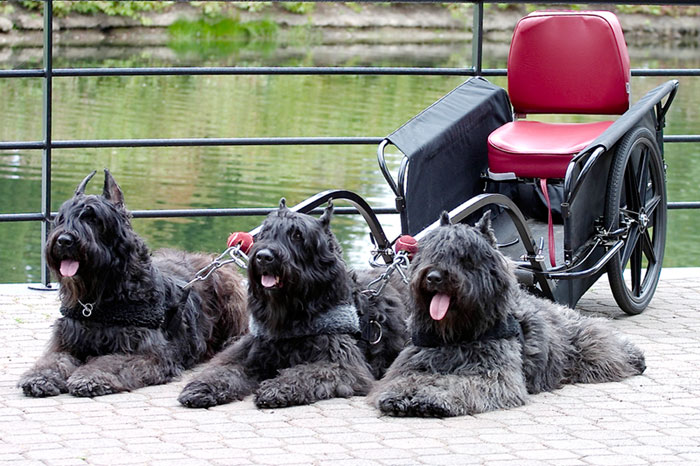
This
is only one of several carts we have. We have a 4 wheel wagon, a mushing
training cart, a couple of different 2 wheel carts, this carriage, a
competition cart and a sulky type cart, and two scooters (one is a all terrain
ATV type with big tires that takes two dogs to pull and one is a small bicycle
type that one dog can pull very fast and two make it fly). We've been doing
carting for a lot of years, although we lost our main lead dogs a while back
and a couple of others are 13 now and don't pull any more.
We
got involved in carting since this was one of the things our breed was used for
from the beginning. And since the Bouvier is a dog that needs a job to keep
them from getting bored and finding things themselves to do (and you don't want
a bored Bouvier 
![lol]() ), and it was easier (and
cheaper) than finding them a herd of cattle to herd, we started carting.
), and it was easier (and
cheaper) than finding them a herd of cattle to herd, we started carting.
At first it was just a small sulky type cart that was basically two wheels, a
seat and two shafts. We used that for awhile and then my wife got the carriage
in the picture above. It helped that the guy that makes them leaves in Portland
near us. Then we started branching out. I bought a mushing rig and the off road
ATV class scooter. She got the smaller scooter, then a wagon, sulky (a bigger
one) and the competition cart. The competition cart is used mostly by some of
the other breeds (Burmese Mt. dogs, Rotties, etc.) but can be used by any
breed. In competition your dog has to demonstrate the ability to maneuver by
voice command around a set up field. There are different levels of competition
from very beginning up to very advanced. Some have to carry a certain amount of
weight (based on the dog) in their cart. There are AKC titles for some breeds
and the Bouvier was only recently recognized by the AKC to be able to get
titles based on carting. Taking so long was very narrow minded by the AKC since
the Bouvier has traditionally been a carting dog.
To start carting is pretty easy, although you want to start out right the first
time so your dog has a positive (at least not a negative) experience. Most
people start out with teaching them the commands for going right, left,
forward, stop and even backup, faster, slower, move right or left (for passing
or being passed like on trails) and others. They also are taught to stand
correctly so the harness can be put on and taken off and whatever they are
pulling is hooked up.
After learning a few basic commands (or while teaching commands) you start
putting a harness on so they can get use to it. There are a bunch of different types
of harnesses too, depending on what kind of carting you are doing and having
the right one can make a big difference. Then you add traces (lines that come
back from the harness like reins with horses) and get them use to something
behind them. You can also add something for them to pull, like a milk carton, a
piece of 4x4, PVC pipe, etc., just to get them use to it. Some are very
skittish with having something right behind them, so going slowly with lots of
praise and treats can really help. With some dogs, they don't seem to mind at
all. What we usually do with new dogs is have someone pull the cart behind the
dog for awhile without hooking it up. That way they get use to something bigger
right behind them. When they finally get hooked up, you want to take it slowly
at first (depending on the dog of course) again with lots of praise and treats.
We like to hook up one of our trained dogs with a new dog. Dogs seem to learn
faster when they have a coach showing them the ropes.
All of this could take a few days to a few weeks, depending on the dog and your
commitment to it. Our dogs go nuts when they see the harnesses come out because
it's something they really like to do... at least they know they are going to
get out and have fun at least. One thing that is important for young dogs. You
don't want to have them start pulling to soon. Most dogs take between a year
and two years before their bones and joints have matured enough to pull any
amount of weight. That doesn't mean young dogs can't be taught the commands or
learn to wear a harness. We have a 19 month old Bouvier that regularly wears a
harness and pulls lines behind him. Of course he's been wearing a service dog
harness or vest for almost a year as part of his service dog training, so he is
use to wearing something. He just got his own pack the other day so he can
start learning to wear one of those and carry some of his own stuff (poop bags,
water, treats, etc.). The other thing about dogs, they are not like horses or
mules. They are not weight carrying animals, although they can carry some
weight, you have to be careful that it is up on their front shoulders and
doesn't weight too much. I think the standard is no more than 25% of their
weight, but I'm not positive about that. They can pull a lot, because they are
using their body and legs, so that's different than actually carrying
something. But you also want to make sure that any shafts do not bear down on
the dog (like when you get in and out of a two wheel cart). The shafts should
go along the side of the dog and not on top to reduce the chance of bearing
down on their backs.
If there are any Burmese Mountain dog clubs in your area, you can probably find
out when they are having a carting trail or demonstration and go watch.
Here are some more pictures. This is a competition cart that a woman had at a
carting session my wife gave...
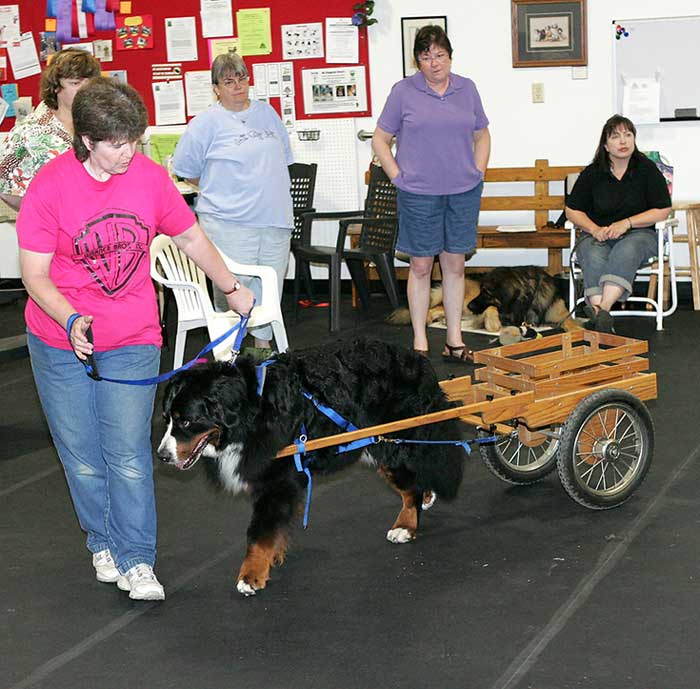
Here
are our sulky, competition cart (without the sides on it), our small scooter
and the other person's cart.

This
is the mushing rig we have with 3 of our Bouviers on the gang line. The Bouvier
in the lead made a great lead dog. The problem was she was also a ground
tracker. So when ever we went out she would take off at a fast run with her
nose to the ground following every twist and turn of what ever trail she was
following. She didn't know how to take a straight line so we had to move her
back to wheel dog and move one of the others up. 

This
is the big scooter I bought. This woman is trying it out with one of her 3
GSP's. Boy did they love to run and pull. She had this scooter just flying
around the parking lot.

This is the cart that the woman above normally has her 3 GSP's pull. It's called a Lynx Cart

It's very light and manuverable, which makes it good for smaller dogs...

Here are some more of the Graham Carriage cart, built by Bob Graham in Portland, Oregon...
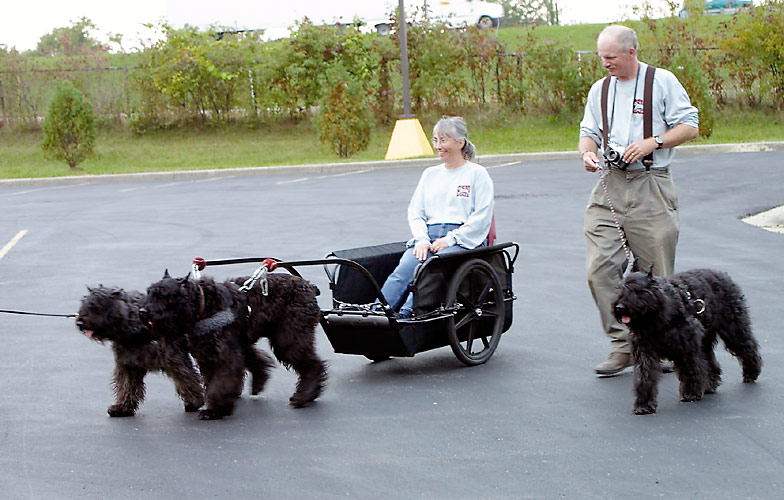
My wife giving a demonstration and talk on carting for Bouviers...
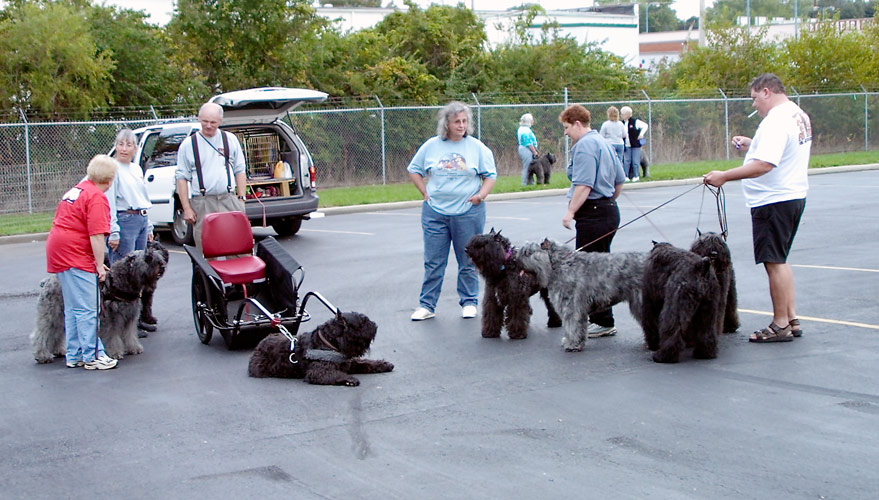
Some friends trying the cart out along the Portland Riverfront (their dog is the one on the left)...
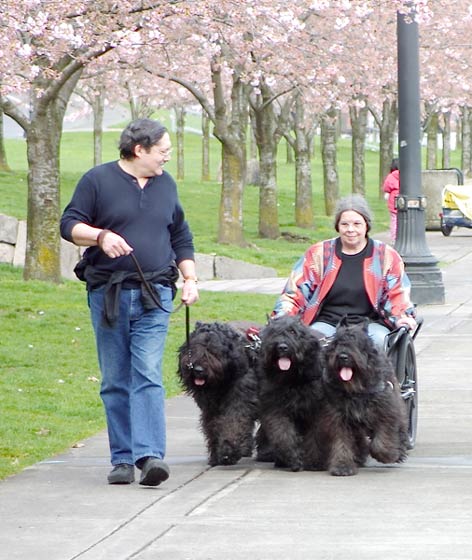
Well, that's some of the fun we have with our dogs. Not only can carting be fun, but it can be healthy for the dogs and humans.
Mike